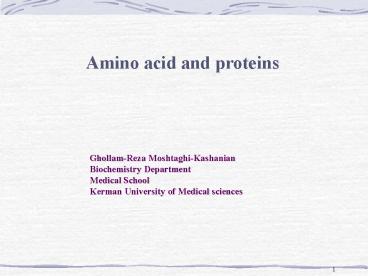Amino acid and proteins - PowerPoint PPT Presentation
1 / 17
Title:
Amino acid and proteins
Description:
Amino acid and proteins Ghollam-Reza Moshtaghi-Kashanian Biochemistry Department Medical School Kerman University of Medical sciences Classification of Bio-Molecules ... – PowerPoint PPT presentation
Number of Views:379
Avg rating:3.0/5.0
Title: Amino acid and proteins
1
Amino acid and proteins
Ghollam-Reza Moshtaghi-Kashanian Biochemistry
Department Medical School Kerman University of
Medical sciences
2
Classification of Bio-Molecules
- Proteins
- Wide range of roles
- Within the cell
- Enzymes
- Structural
- Gene activators / suppressors
- Membrane receptors / transporters
- Contractile elements
3
- Proteins
- Wide range of roles
- Outside of the cell
- Enzymes
- Structural
- Hormones
- Antibodies
- Toxins
- Transporters
- (Membrane receptors / transporters)
4
- Proteins
- How do they accomplish so many functions?
- A multitude of shapes
- Interact selectively with other molecules
- High specificity
5
- Proteins
- Structure
- Polymers of amino acid (aa) monomers
- Two aspects of aa structure
- Shared properties
- Properties unique to each aa
6
- Proteins
- Amino Acids Shared properties
- A carboxyl and an amino group separated by a
carbon atom the a carbon. - At physiological pH the a carboxyl looses a
proton and the amino group accepts a proton
7
- Proteins
- Amino Acids Shared properties
- During protein synthesis each amino acid is
linked to the next via a peptide bond forming a
polypeptide - A peptide bond results from the linkage of the
carboxyl group of one amino acid to the amine
group of its neighbor, with the elimination of a
molecule of water
8
- Proteins
- Amino Acids Unique properties
- The side chain group or R group 20 forms
- R group properties provide the basis of the
diverse structure and activities of proteins.
9
- Amino Acids Unique properties
- The side chain group or R group 20 forms
10
- Amino Acids Unique properties
- The side chain group or R group 20 forms
11
- Proteins
- Structure
- Description at several levels of organization
- Primary, secondary, tertiary, quaternary
12
- Proteins
- Structure
- Primary
- aa sequence
- Possible variations x 20n, where n the no.
aa in the polypeptide - If n 10
- X 1013
- If n 20
- X 1026
13
- Proteins
- Structure
- Secondary
- Conformation of specific regions
- Two specific types
- Alpha helix
- Beta-pleated sheet composed of b strands
- Portions not organized into an a helix or a b
sheet consist of turns, hinges, loops or
finger-like extensions
14
- Proteins
- Structure
- Secondary
- In pictorial representations a helices are shown
as helical ribbons and b strands as flattened
arrows
15
- Proteins
- Structure
- Tertiary
- The conformation of the entire protein
Leptin
Ribonuclease
16
- Proteins
- Structure
- Quaternary
- Multiples of single polypeptides linked together
- Each polypeptide is termed a subunit
- May be linked by
- Covalent disulfide bridges
- Non-covalent between hydrophobic patches
- In two-polypeptide proteins
- if the subunits are identical it is a homodimer
- If the subunits are different it is a
heterodimer
17
- Proteins
- Structure
- Dynamic changes within proteins
- Protein structure is not rigid or inflexible
- Capable of considerable internal movements
- Some random and small-scale
- Predictable changes triggered by interaction with
another molecule are conformational changes - Complexes of proteins form and break
- Association and Dissociation
- Interacting proteins have complementary surfaces
- As they come into close contact their interaction
is stabilized by non-covalent bonds































